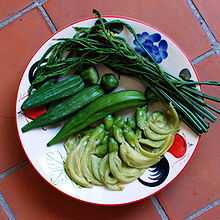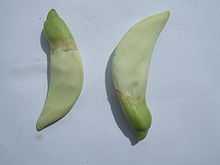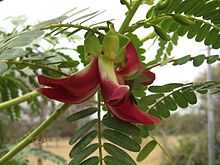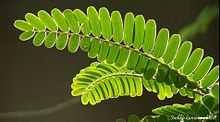Sesbania grandiflora
| Sesbania grandiflora | |
|---|---|
 | |
| Scientific classification | |
| Kingdom: | Plantae |
| (unranked): | Angiosperms |
| (unranked): | Eudicots |
| (unranked): | Rosids |
| Order: | Fabales |
| Family: | Fabaceae[1] |
| Genus: | Sesbania |
| Species: | S. grandiflora |
| Binomial name | |
| Sesbania grandiflora (L.) Poiret | |
Sesbania grandiflora (syn. Aeschynomene grandiflora, Agati grandiflora)[2] also known as agati or hummingbird tree/scarlet wisteria, is a small tree in the genus Sesbania.
Description
It is a fast-growing tree, leaves are regular and rounded and the flowers white and red in color according to its species. The fruits look like flat, long and thin green beans. The tree thrives under full exposure to sunshine and is extremely frost sensitive.
Its a small soft wooded tree up-to 3-8m, leaves 15–30 cm long; leaflets 10-20 pairs or more and an odd one. Oblong, 1.5-3.5 cm long variety red, 7.5–10 cm long in lax, 2-4 flower racemes, calyx campanulate, shallowly 2-lipped. Pods slender, falcate or straigh, 30–45 cm long, suture thick, Seeds ca. 30, to 8mm.a twig of sesbania



| Nutritional value per 100 g (3.5 oz) | |
|---|---|
| Energy | 113 kJ (27 kcal) |
| Carbohydrates | 6.73 g |
| Fat | 0.04 g |
| Protein | 1.28 g |
| Thiamine (vit. B1) | 0.083 mg (7%) |
| Riboflavin (vit. B2) | 0.081 mg (7%) |
| Niacin (vit. B3) | 0.43 mg (3%) |
| Folate (vit. B9) | 102 μg (26%) |
| Vitamin C | 73 mg (88%) |
| Calcium | 19 mg (2%) |
| Iron | 0.84 mg (6%) |
| Magnesium | 12 mg (3%) |
| Phosphorus | 30 mg (4%) |
| Potassium | 184 mg (4%) |
| Link to USDA Database entry Percentages are roughly approximated using US recommendations for adults. Source: USDA Nutrient Database | |
Origin and Distribution
Indigenous from Malaysia to North Australia; Cultivated in many parts of India. It has a large number of traditional uses.[3] It grows where there is good soil and hot humid temperature. Die in snow, cold weather. It's a tropical plant.
Chemical Constituent
It contain arginine, cysteine, histidine, isolcucine, phenylalanine, tryptophan, valine, threonine, alanine, aspargine, aspartic acid, oleanolic acid, galactose, Rhamnose & glucuronic acid.
Properties and Uses of different Parts
Leaves used as tonic, diuretic, laxative, antipyretic, chewed to disinfect mouth and throat. Flower in headache, dimness of vision,[4] Catarrh, Headache, cooling and improving appetite, bitter, astringent, acrid, antipyretic. Bark is used for cooling (ayurvedha and siddha medicinal terms), bitter tonic, anthelmintic, febrifuge, diarrhea, Small pox, Astringent.[5] Fruits in Bitter & acrid, laxative, fever, pain, bronchitis, anemia, tumors,[6] colic, jaundice, poisoning. Root used in Rheumatism, Expectorant, Painful swelling, Catarrh.[7]
Culinary uses
The flowers of S. grandiflora are eaten as a vegetable in Southeast Asia, like Laos, Thailand, Java in Indonesia, Vietnam, and the Ilocos Region of the Philippines.
In the Thai language the flowers are called ดอกแค (dok khae) and are used in the Thai cuisine both cooked in curries, such as kaeng som and kaeng khae,[8] as well as raw with nam phrik.[9]
The young pods are also eaten, along with the leaves. In Sri Lanka, agati leaves, known as Katura murunga in Sinhala language, are sometimes added to sudhu hodhi or white curry, a widely eaten, thin coconut gravy and is believed locally to be a cure for canker sores. In India this plant is known as agati (Hindi), agastya (Kannada), agise (Telugu), and both the leaves and the flowers have culinary uses.
Common names
- Indic languages:
- Hindi: गाछ मूंगा (gaach-munga)
- Malayalam: അകത്തി (അഗത്തിച്ചീര)(akatti)
- Sinhala (Sri Lanka) : කතුරුමුරුංගා (kathurumurunga)
- Sanskrit: अगस्ति[10] (agasti)
- Kannada: agase
- Oriya: ଅଗସ୍ତି (agastee)
- Tamil: அகத்தி (akatthi)
- Telugu: అవిసి (avisi)
- Marathi: हेटा (heta)
- Bengali :বক ফুল (Bokful or Heron flower, as its white and hangs like a heron from the tree.)
- South-east Asian languages:
- Indonesian: bunga turi ; kembang turi
- Lao: ແຄ(ຂາວ) [kʰɛ́ː kʰǎːw]
- Khmer: ផ្កាអង្គាដី (pka angkea dey)
- Tagalog: katuray
- Thai: แค (khae)
- Vietnamese: so đũa
- Chinese language: 大花田菁 (da4 hua1 tian2 jing2)/ 木田菁/ 紅蝴蝶.
See also
References
- ↑ Prajapti, Purohit, Sharma, Kumar , A Handbook of medicinal plants, Agro Bios (India), Edition Ist 2003, Page.473
- ↑ Joshi S. G. ,Medicinal Plants, Medicinal plants, Oxford & IBH Publishing Co. Pvt. Ltd. bks)
- ↑ Kirtikar K. R. & B. D. Basu, Indian Medicinal Plants Vol-I, International Book Distributor & Publisher, Dehradun, Edition 2005, bksPage. 735-736
- ↑ Joshi S. G. ,Medicinal Plants, Medicinal plants, Oxford & IBH Publishing Co. Pvt. Ltd. bks
- ↑ Prajapti, Purohit, Sharma, Kumar , A Handbook of medicinal plants, Agro Bios (India), Edition Ist 2003, Page.473 bks
- ↑ Kirtikar K. R. & B. D. Basu, Indian Medicinal Plants Vol-I, International Book Distributor & Publisher, Dehradun, Edition 2005, Page. 735-736 bks
- ↑ Late Dr. Nadkarn’s K. M, The Indian Material Medica Vol –I, Bombay Popular Prakasan, Edition-2007, Page. 52-53.
- ↑ Kaeng Khae Kai (Katurai Chilli Soup with Chicken)
- ↑ Thailand Illustrated Magazine
- ↑ Cologne Digital Sanskrit Dictionaries - Monier Williams Sanskrit-English Dictionary page 4
External links
- Sesbania grandiflora on Tropicalforages.info
- Sesbania grandiflora in the AgroForestry Database of the World Agroforestry Centre
- Sesbania grandiflora on the FAO web site
- Sesbania grandiflora on the web site of the Center for New Crops & Plant Products at Purdue University.
- " Sesbania Seeds Exporter Kohenoor International Pakistan"
| Wikimedia Commons has media related to Sesbania grandiflora. |
